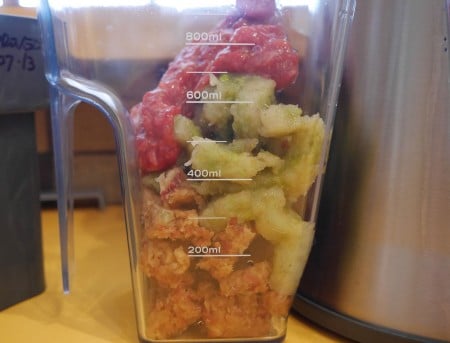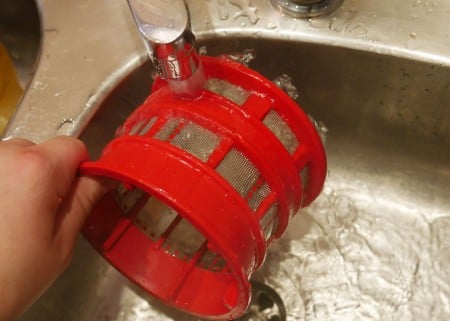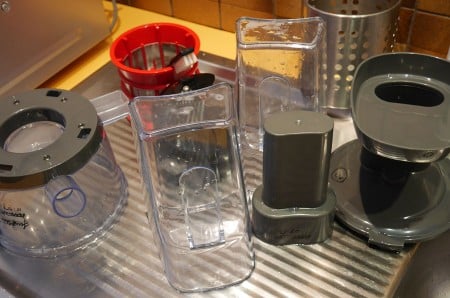The process Sunbeam is using for the Slow Juicer doesn’t appear to be quite as drawn out as what we experienced in the Oscar Neo Juicer, and while that model knocked the fruit around from different sections, crushing it as it travelled before finally forcing it through the comb filter, the Sunbeam takes on a much faster approach, crushing it heavily once and then pushing it through the filter.
This way of working means you get juice quickly using the “slow” method, but it also means the fibre pushed through the juicer retains far more moisture than what we saw in the other more expensive slow juicer, and the differences are literally night and day in this waste product.

Fibre expelled from the Oscar slow-juicer was practically dry, and if you put it in your mouth, you would spit it back out again, since it was entirely tasteless.
Sunbeam’s expelled fibre, on the other hand, obviously still has liquid in it, visible not just in the hand when touching it, but also in photographs, and when you put this in your mouth, it tastes kind of like baby food, and is still edible.
That’s a dramatic difference, and points out that Sunbeam’s slow juicer isn’t doing as heavy an extraction as competing products.

What it does manage to do, however, is simplify the process.
The Sunbeam JE9000 doesn’t have many parts, and putting it together — as well as cleaning it — is much easier than you might expect, and there are no blades to touch.
There is a compartment, a chute with protective cover, heavy black juicing screw, and comb filter, as well as two jugs built to go around the motor that sits beneath all of this.

Putting this together is as easy as fitting the right parts together and aligning arrows, while cleaning involves taking these apart, and running them either through hot water with the supplied brush (if you’re having trouble with the filter) and/or some soapy water.
You can also run water between juicing cycles, which will help to clean out the insides, as well as push out any remaining fibre before you give it a good cleaning piece by piece.
Because of these very small parts, though, it is therefore very easy to clean, and is also much more accommodating for bench space, taking up roughly half what another brand of slow pressure juicer took up when we reviewed it.

Conclusion
While most people are familiar with the centrifugal blade juicer, the slower pressure based juicer appliance is just now gaining momentum, and aims to get more juice out of that fruit than the slice and dice ways of the other type.
Sunbeam’s pressure juicer manages to accomplish this at a decent price premium, especially against the king of the hill model we tested from rival Oscar, which comes in at $200 more and occupies more bench space.
The differences between these models are noticeable, mind you, and while the Oscar is more expensive, it does a better job of crunching every last drop of juice out, while also affording you the ability to make noodles and breadsticks.
That said, if you’re buying a juicer to juice, we’re actually recommending the Sunbeam over the Oscar.
Technically, the Oscar does a better job, but its setup is more fiddly, with more bits and pieces and less room to work with in your kitchen.
The Sunbeam, though, is faster per batch of fruit, smaller, and easier to clean up, and those features, as well as the less expensive entry price, make it worth checking out.
































It seems almost identical to an Akon juicer I had. The bayonet retaining clips which hold the juicing bowl to the base were made of plastic and broke off 3 times within the warranty period. Having sent the item for warranty repair twice, I gave up un the 3rd occasion and trashed it.
We didn’t have this, though if there are problems, it might be an idea to contact Sunbeam and see if there’s a replacement you can organise.
We favour the vertical slow juicer like the Hurom, mainly due to the easy cleaning and good all round juicing capabilities, plus they are made in Korea not China. Since juicing every day, we have felt amazing benefits and our health as improved dramatically. We also find most juices are very tasty and the more you juice the more accustomed to the flavours you get and the ‘greener’ juices are even tasty after a while. We think everyone should get a juice habit and try and juice every day, you will love it. Thanks for the great blog and getting the awareness out there for such a wonderful way to live.
Great post. This article has immensely great information regarding juicers and juicing which is really impressive. I normally do juicing and this adds constructive information to my knowledge base.